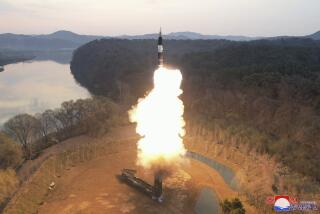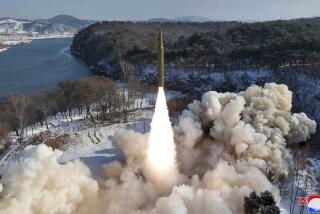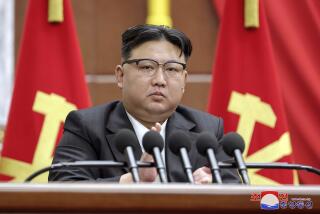Pentagon confirms North Korea tested second ICBM in less than a month

The missile launched July 28 from Mupyong-ni in Chagang province, in northern North Korea and flew about 45 minutes. (Sign up for our free video newsletter here http://bit.ly/2n6VKPR)
North Korea launched its second intercontinental ballistic missile in less than a month on Friday in a test that indicated remarkable technological progress in the isolated nation’s weapons development, Pentagon officials said.
Although the Pentagon had yet to make final assessments, independent defense analysts said the two-stage missile appeared the most powerful that Pyongyang has ever tested.
They estimated that it flew about 45 minutes and soared about 1,850 miles into space before it crashed down in the Sea of Japan off the coast of Hokkaido, Japan’s northern island.
If that trajectory were flattened out, the analysts said, in theory the missile has the capability for the first time to threaten California and beyond.
President Trump, who has repeatedly warned of the threat from North Korea and made it a foreign policy priority, issued a statement late Friday expressing, as in the past, objection to the “reckless and dangerous action.”
”The United States will take all necessary steps to ensure the security of the American homeland and protect our allies in the regions,” he said.
The missile test — issued from a mobile launcher shortly before midnight, and from a rural site not previously used near the Chinese border — appeared designed to show it would be difficult to shoot down.
“A night launch from an unexpected location” was intended to “show us that we don’t have a credible pre-emption option,” said Jeffrey Lewis, a nuclear weapons analyst with the nonpartisan James Martin Center for Nonproliferation Studies in Monterey.
It was North Korea’s 18th missile test this year, placing the nation on a record-setting pace.
Gen. Paul Selva, vice chairman of the Joint Chiefs of Staff, told the Senate Armed Services Committee last week that “Kim Jong Un and his forces are very good at camouflage concealment and deception.”
He added that Pyongyang has yet to fine-tune its missile guidance and control systems and hasn’t shown the “capacity to strike the United States with any degree of accuracy or reasonable confidence of success.”
The latest missile was launched from Mupyong-ni in Chagang province, in northern North Korea.
Pyongyang first tested a prototype ICBM, dubbed the Hwasong-14, on July 4 in a flight that lasted 37 minutes, raising alarms that it had achieved a breakthrough in its missile program.
The high arc of the trajectory led U.S. analysts to conclude for the first time that Pyongyang had attained the capability of building a missile that could reach Alaska and possibly Hawaii.
Although Pyongyang has developed and tested nuclear weapons, it is not known to have developed a nuclear warhead small enough to fit atop an ICBM or robust enough to survive the missile’s fiery reentry into the atmosphere.
But the string of underground nuclear tests and increasingly sophisticated missile flights have led to concerns it could soon develop the capability to launch a nuclear-armed missile at American military targets in Asia — or even the U.S. mainland.
Given that progress, U.S. intelligence agencies recently cut their projections of how long it would take Pyongyang to build a missile capable of reaching the U.S. mainland from four years to one year.
The Pentagon vowed Friday to defend regional allies and noted that the missile did not threaten North America.
“Our commitment to the defense of our allies, including the Republic of Korea and Japan, in the face of these threats, remains ironclad,” Pentagon spokesman Capt. Jeff Davis said in a statement. “We remain prepared to defend ourselves and our allies from any attack or provocation.”
Gen. Joseph Dunford Jr., chairman of the Joint Chiefs of Staff, and Adm. Harry Harris, commander of U.S. Pacific Command, telephoned South Korea’s top military official, Gen. Lee Sun Jin, and “expressed the ironclad commitment” to the U.S.-Korean alliance, the Pentagon said in a statement.
“The three leaders also discussed military response options,” the statement said.
Prime Minister Shinzo Abe of Japan called a meeting of his country’s National Security Council.
“I have received information that North Korea once again conducted a missile firing,” he said. “We will immediately analyze information and do our utmost to protect the safety of the Japanese people.”
The United Nations Security Council has repeatedly slapped sanctions on North Korea since its first nuclear test in 2006. While the measures have cut the country off from much of the world’s economy, they have failed to halt its advances in military know-how.
Congress this week overwhelmingly passed legislation that would place additional sanctions on North Korea, as well as Russia and Iran, and limit the president’s ability to ease them. The White House has not said if Trump will sign the bill.
ALSO
Duck and cover 2.0: How North Korea is prompting new efforts to prepare for a nuclear attack
Trump ousts Reince Priebus as chief of staff in latest White House shakeup
Trump urges officers and immigration officials to be ‘rough’ on ‘animals’ terrorizing U.S. neighborhoods
UPDATES:
4:05 p.m.: This article was updated with White House reaction.
12:05 p.m.: This article was updated with staff reporting.
9:20 a.m.: This article was updated with additional details and confirmation from South Korea and the U.S. of the launch.
This story was originally posted at 8:35 a.m.
More to Read
Start your day right
Sign up for Essential California for news, features and recommendations from the L.A. Times and beyond in your inbox six days a week.
You may occasionally receive promotional content from the Los Angeles Times.







